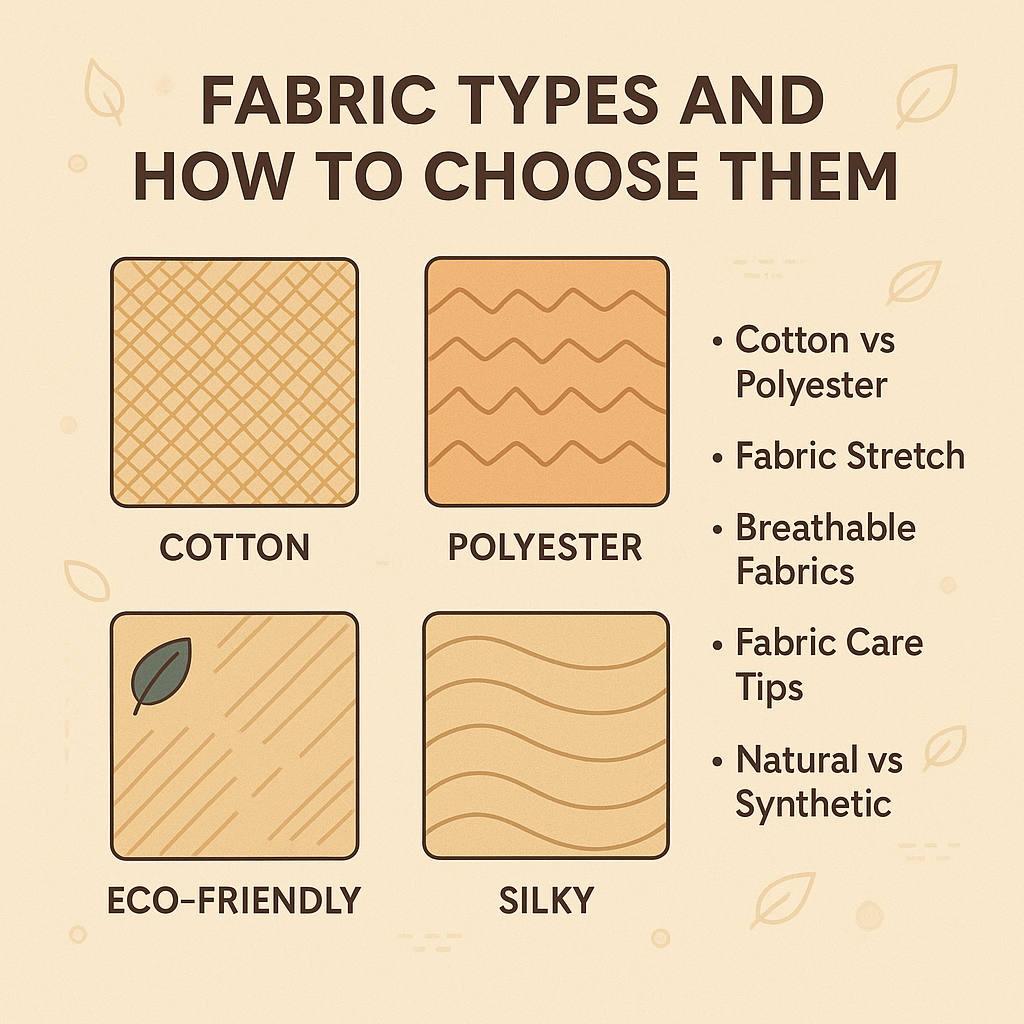
Understanding fabrics is essential for every sewing enthusiast. Whether you’re crafting a casual dress or a formal outfit, knowing the fabric types and their properties can make or break your project. This Fabric Guide covers everything you need—from choosing fabric to caring for it properly—so you can create beautiful, lasting garments with confidence.
Common Fabric Types Explained
Each fabric behaves differently based on its fiber content, weave, and finish. Here’s a quick look at popular options:
- Cotton: Breathable, soft, and ideal for everyday wear.
- Polyester: Durable, wrinkle-resistant, and holds colors well.
- Silk: Luxurious and lightweight; perfect for elegant projects.
- Linen: Highly breathable and textured, great for warm climates.
- Wool: Insulating, warm, and perfect for winter garments.
- Rayon: Soft and versatile, mimics the feel of natural fibers.
Cotton vs Polyester: Which One to Choose?
One of the biggest decisions when choosing fabric is between cotton vs polyester:
| Feature | Cotton | Polyester |
|---|---|---|
| Breathability | Excellent | Moderate |
| Durability | Good | Very high |
| Eco-friendliness | Biodegradable | Not biodegradable |
| Feel | Soft and natural | Smooth and synthetic |
| Care | May shrink, needs ironing | Easy-care, wrinkle-resistant |
Tip: If comfort and breathability are your priorities, go for cotton. If you need strength and low-maintenance garments, polyester is a better pick.
How to Choose the Right Fabric
When choosing fabric, consider:
- Purpose of the project (daily wear, evening gown, sportswear)
- Fabric stretch for better fit and movement
- Climate (hot climates need breathable fabrics)
- Care requirements (some fabrics are high maintenance)
Understanding Fabric Stretch
Fabrics can be non-stretch, two-way stretch, or four-way stretch:
- Non-stretch: Best for structured garments like jackets.
- Two-way stretch: Stretch in one direction; good for fitted tops.
- Four-way stretch: Stretch in both directions; perfect for leggings and body-hugging dresses.
Always consider fabric stretch when picking fabric for a project that requires mobility or a snug fit.
Eco-Friendly and Breathable Fabrics
Sustainability matters! Eco-friendly fabrics include:
- Organic Cotton
- Hemp
- Tencel
- Bamboo Fabric
Meanwhile, breathable fabrics like cotton, linen, and bamboo allow air circulation, keeping you cool and comfortable.
Tips for Sewing Silky Fabrics
Sewing silky fabrics like silk or satin can be tricky. Here’s how to make it easier:
- Use a sharp needle (size 60/8 or 70/10)
- Cut with very sharp scissors or a rotary cutter
- Use tissue paper underneath while sewing to prevent slipping
- Pin carefully and sparingly
Fabric Care Tips
Keeping your creations looking fresh involves proper maintenance:
- Read labels for washing instructions.
- Pre-wash your fabrics before cutting to avoid shrinkage.
- Use appropriate detergents for delicate or colored fabrics.
- Avoid high heat when drying or ironing sensitive materials.
Simple fabric care tips can significantly extend the life of your handmade pieces!
Fabric Textures and Feel
Understanding fabric textures helps you match fabric with the garment style:
- Smooth (satin, silk): Great for formal wear.
- Rough (canvas, tweed): Suitable for jackets and outerwear.
- Soft (jersey, fleece): Ideal for casual and loungewear.
- Crisp (taffeta, organza): Perfect for structured dresses.
Natural vs Synthetic Fabrics
| Characteristic | Natural Fabrics | Synthetic Fabrics |
|---|---|---|
| Source | Plants or animals | Chemical processes |
| Breathability | Higher | Lower |
| Durability | Moderate | High |
| Eco-friendliness | More eco-friendly | Less eco-friendly |
| Examples | Cotton, wool, linen | Polyester, nylon, acrylic |
Knowing the difference between natural vs synthetic helps you make smarter, more sustainable fabric choices.
Conclusion
Fabric knowledge is a game-changer for sewing success. From sewing silky fabrics to picking eco-friendly fabrics, understanding textures, care, and stretch properties will transform your DIY projects. Whether you are just starting or perfecting your craft, this fabric guide will help you learn to sew smarter and create more stunning garments!

Leave A Comment